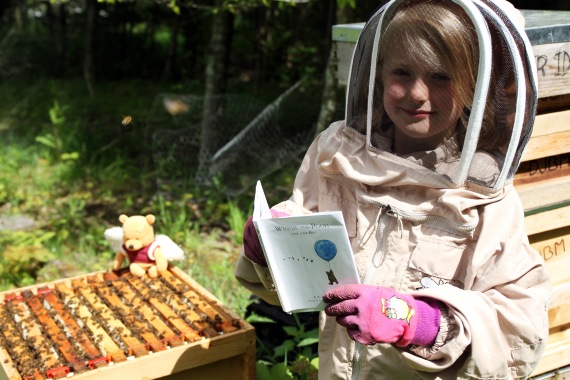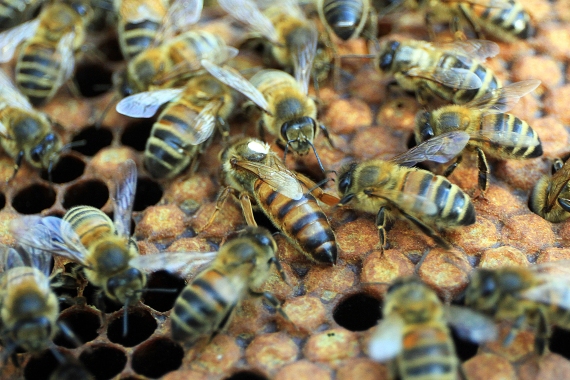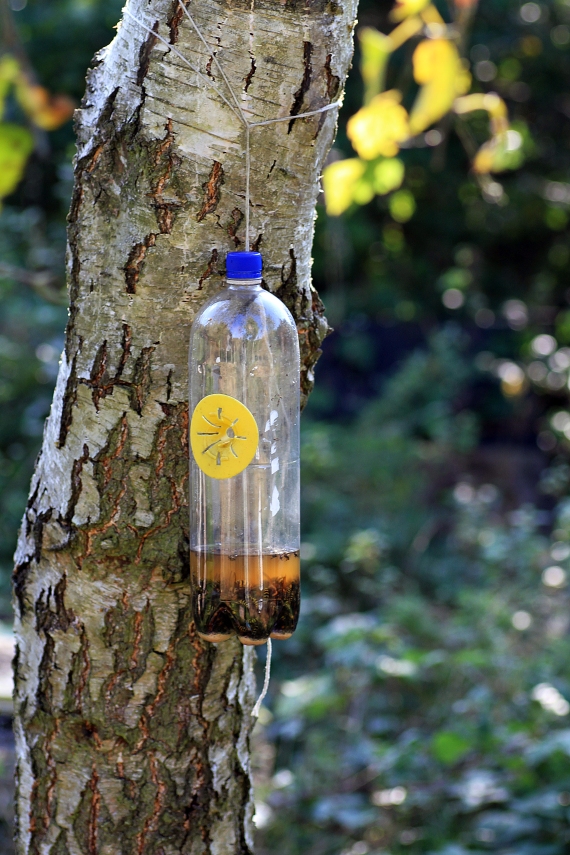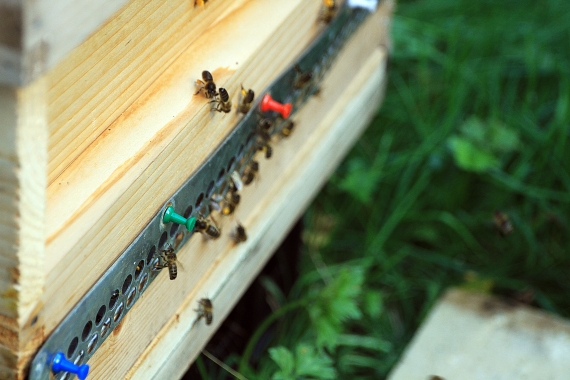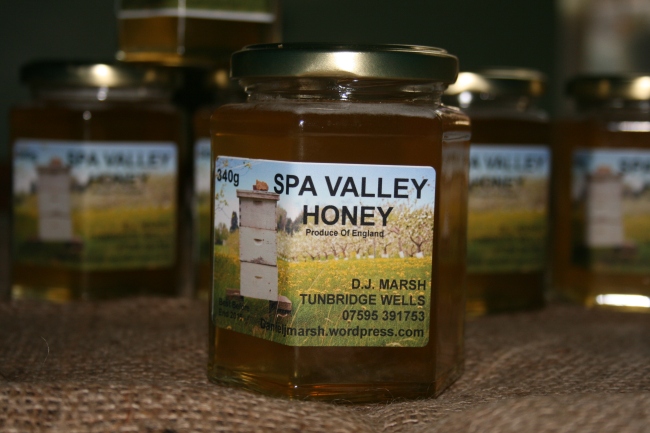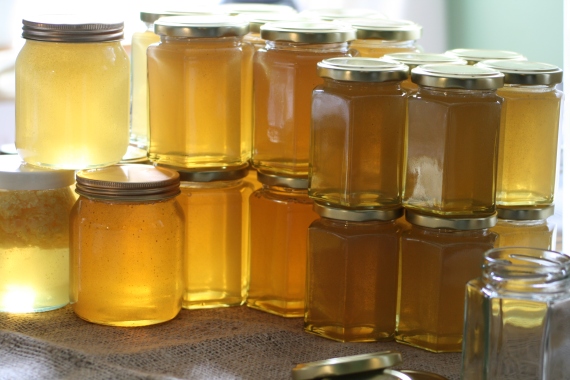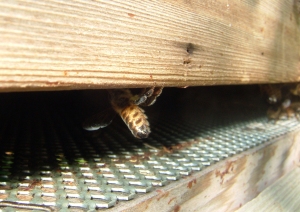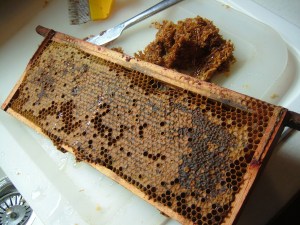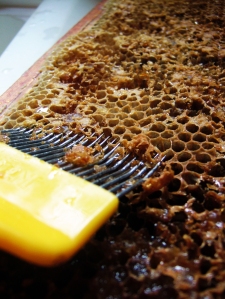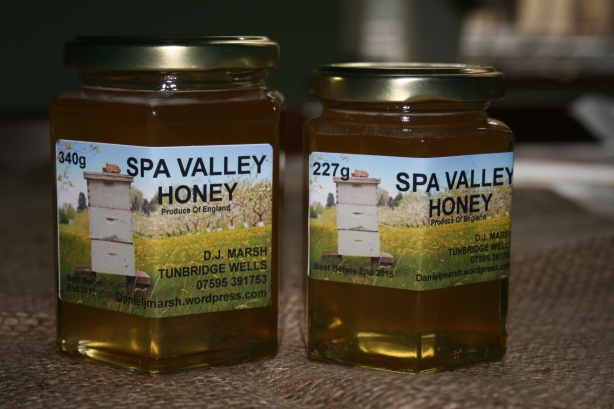September is virtually on our doorstep, sadly it is beginning to feel distinctly autumnal in the UK with below average temperatures and continued bands of rain crossing the UK and I am now turning my thoughts to preparing my bees for the long winter period ahead.
I often get asked ‘so where do the bees go over winter?’ I would like to say that they escape for some winter sun, the Canaries are a popular destination …. but the reality is not quite so nice. The bees have worked hard all spring and summer, on the few dry and warm days when they have been able to fly, collecting the various different nectars from flowering plants and trees. The nectar has been converted into honey, then its water content has been further reduced to stop it fermenting before it has been safely stored away inside a ‘capped’ wax cell to help sustain the colony over winter. Along comes the beekeeper in August and a certain amount of this honey is removed from the hives, and although a fair bit is also left on the hives, it is necessary to give the bees something back to try and prevent them from starving over the winter, or far more likely during the early spring period.

Feeding the bees
The colony size increases early in the year, with a large workforce required to collect pollen to feed the brood and nectar to feed workers as well as process the stores, but as summer nears its end the queen slows her egg laying down and the colony size reduces again so that there are less mouths to feed over winter. The bees being produced now (all female workers) will have a longer life span than their siblings born earlier in the year, surviving for several months as opposed to about 5 weeks, as the flowering plants reduce and finally disappear these bees will have hive duties only so will not literally work themselves to death. Instead their lives will be about protecting the queen over the winter and preparing the hive for the colony expansion to coincide with spring next year. The job of the drones (male bees) was mainly to fertilise any virgin queens and with this task completed for 2012 their lives as idle layabouts with all needs being tended to ends abruptly, the workers don’t need extra mouths to feed during the hard months ahead, and they are driven out of the hives into the cold and wet when they will perish. The queen will produce more drones next year when they are required!
Once the honey has been removed the hives are assessed for levels of stores left behind and any shortfall is made up using a heavy sugar syrup (1kg sugar: 500ml water). This must be done in August and early September to utilise a workforce that is still large enough to process the syrup and generate temperatures high enough inside the hive to reduce its water content sufficiently, once the ambient temperature drops and the colony reduces in size it would become a much harder, near impossible task and there would be a risk of fermentation which would lead to approximately 12,000 bees with diarrhea being trapped in a small wooden box together for the next 5 months – not a particularly nice thought.

Contact feeder on the hive
The sugar syrup is feed to the bees above the crown board on top of the hive. As it is ‘outside’ of the hive as far as the bees are concerned they work tirelessly to ‘rob’ this new nectar source and store it in the comb cells below. Different types of feeder are used, I have always used ‘contact feeders’, an inverted bucket with a gauze panel where the bees can access the syrup. The vacuum in the bucket prevents the syrup from pouring into the hive, this year I am also trialling an ‘Ashforth feeder’ which is about the size of a honey super with holes along one side to allow the bees to climb up into the box. The advantage of this is that you can put a large volume of syrup on the hive in one hit rather than having to keep returning to refill the smaller contact feeder, the disadvantages is that the bees have to climb up into the box and find it. I dribbled a little syrup through the holes when I placed it on the hive and it was near empty after the first week (3kg sugar syrup) so I am now happy that it works.

Ashforth feeder on the hive
I try to disturb the bees as little as possible during this period, they are not likely to swarm (although not totally unheard of) but it is necessary to treat the colony for mite infestation. There is a lot already written on-line about Varroa Destructor, basically a bee parasite that is an Asiatic mite that breeds in the brood cells and sucks the blood from the adult bees. The mites reproduction cycle is only 10 days so is substantially quicker than that of the bees, they hatch from the bees cells as mature mites often mated and ready to lay eggs, therefore they can increase their number at a much faster rate. As the bees reduce their numbers for the winter the mites still reproduce, further weakening the colony. The mites prefer to reproduce in the slightly larger drone cells but as the queen stops laying drone eggs the mites move into the worker cells and if a critical level is reached they then have the potential to collapse (or kill) the colony. This has become a widespread problem in the UK over the last 20 years and most beekeepers have an integrated pest management plan that they implement each year to reduce the mite numbers and colony stress.

Varroa Destructor – treatment
Personally I treat the bees with an organic treatment called Apilife Var during August and September whilst I am feeding the syrup, I then return at the end of December when there is no brood in the hive and treat again with oxalic acid which kills the mite but doesn’t seem to harm the bees. The Apilife Var is a strip of material that is placed into the hive directly above the brood and then releases strong thymol vapours. This is repeated on a weekly basis for a four week period so ties in nicely with the syrup feeds.
I also use open mesh floors under the hives, this increases ventilation and prevents water pooling in the bottom of the hive (a potential problem with solid floors if the hive is not level or slightly sloped forwards – damp is a bigger killer of bees than the cold!) but it also allows any mites that drop off the bees to fall through the mesh and they are unable to return to the hosts. I am not convinced that many drop off naturally but the main use of a mesh floor is to allow a ‘count board’ to be placed under the hive during mite treatment, or at other times of the year. This is left on for a number of days before removal and the number of mites are counted, divided by the number of days the board was in place and using an on-line calculator gives an indication of the level of infestation in the hive.
More information on managing Varroa can be found at the BeeBase website which also includes the current advisory leaflet.

Invaders must die!
Other pests are often removed from the hives by the bees themselves, like this optimistic slug that fancied some honey!
Once the bees have stopped flying for the year they will cluster in the hive, protecting the queen and maintaining a temperature, slightly lower than required for rearing young, but warm enough to keep them from freezing. 100 million years of evolution has allowed them to perfect this comatose state where very little energy is used and therefore very little food is required. However when the queen starts egg laying at the beginning of next year getting ready for the spring flow the bees will break open their stores of honey and pollen and that is why this period poses the greatest risk for starvation to the colony. If the spring flowers are late again or it is particularly wet the beekeeper needs to feed a light syrup to the bees to prevent this.
With the current changes in the UK weather patterns that have been recorded over the recent years the bees need all the help they can get if they are going to carry on pollinating the crops that produce the food that we require to survive – only a fool would think that they need us to survive long term, sadly the reversal of this statement is not quite so true.
I hope you have enjoyed reading the blog, feel free to contact me with comments, suggestions or general feedback, click on the right column to subscribe and receive updates when I next have the time between chasing the bees to write again.
I can also be found at @danieljmarsh on twitter or British Beekeepers page on Facebook.
Dan
N.B. clicking on the images opens a higher resolution image in a new window.
51.132446
0.263315



